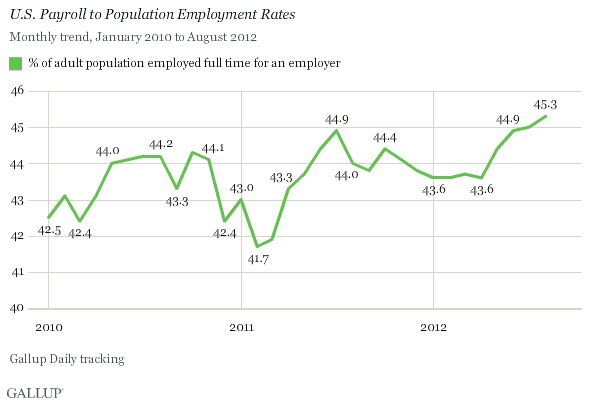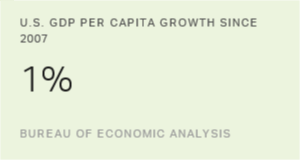WASHINGTON, D.C. -- Just over 45% of Americans aged 18 and older were employed full time for an employer in August, according to Gallup's new Payroll to Population measure. This new metric estimates the percentage of the U.S. adult population -- not just the workforce -- who are employed full time for an employer for at least 30 hours per week.

These results are based on Gallup Daily tracking interviews, conducted by landline and cell phone, with more than 30,000 Americans throughout the month. Adults who are self-employed, working part time, unemployed, or out of the workforce are not counted as payroll-employed in the Payroll to Population metric. Payroll to Population is not seasonally adjusted.
Gallup also tracks U.S. unemployment and underemployment, but its global research has shown that the number of people in a country working full time for an employer is the measure most highly correlated with GDP.
Gallup tracks Payroll to Population rates globally based on its World Poll survey, which includes adults aged 15 and older, to account for the different employment situations in countries worldwide. The U.S. Payroll to Population rate for adults aged 15 and older is 41%.
U.S. Payroll to Population Up Since 2010
Although this is Gallup's initial report on U.S. Payroll to Population, Gallup has collected employment data on Americans daily since January 2010. An analysis of the longer-term data finds that August's 45.3% measure is the highest Payroll to Population rate since January 2010. August 2012's percentage is significantly higher than August 2011's 44.0% and August 2010's 44.2%.
Similar to other employment measures, Payroll to Population has seasonal ups and downs, with dips in the late fall and winter, and increases during summer months. The trend on this measure corresponds to the general trend in Gallup's Job Creation Index. The 2010 low point, experienced in March, was 42.4%, and the high point was 44.3% in October, a high-to-low difference of 1.9 percentage points. The seasonal differences in 2011 were more pronounced, with a low of 41.7% in February and a high of 44.9% in July, a difference of 3.2 points. Seasonal swings for 2012 appear to be more in line with 2010, with a difference of 1.7 points so far. Still, the current 2012 low point of 43.6% is more than a full point higher than the lows of 2010 and 2011. The relative stability of 2012 may be a promising sign of more confident employers and greater job market stability.
Payroll to Population an Alternative to Unemployment
Gallup's Payroll to Population employment measure adds value to the understanding of the economy beyond that provided by the unemployment rate, the current gold standard of employment metrics. Both Gallup and the U.S. Bureau of Labor Statistics assess unemployment, but Payroll to Population is a measure unique to Gallup. Payroll to Population is a straightforward measure based on the number of adults in the total population who work for an employer at least 30 hours per week. As the employment situation improves or deteriorates, or as populations move in and out of the workforce, Payroll to Population will do the same, and is a true representation of the economic energy of the country.
In contrast, unemployment rates are based on the number of adults in the workforce who are looking for and available for work. This classic measure has become the main gauge of the nation's employment situation, and its long trends provide significant value, but the unemployment statistic also can paint an incomplete -- or in some instances, misleading -- portrait of the status of the workforce. Case in point, in the August jobs report released Friday by the Bureau of Labor Statistics, there was a drop in the size of the workforce -- reflecting more discouragement among job seekers -- that helped to bring the unemployment rate down.
Additionally, the government's Bureau of Labor Statistics calculations involve elaborate adjustments each month, which can mask underlying trends, and traditional unemployment metrics count Americans who are working at least one hour per week as employed. In contrast, Payroll to Population will only increase or decrease if there is a change to the number of Americans working full-time jobs.
Bottom Line
The August increase in Payroll to Population is a positive sign as the United States continues on the road to economic recovery. As underemployed Americans find work or rejoin the workforce, Payroll to Population will continue to improve.
Payroll to Population admittedly excludes some groups of employed Americans such as the self-employed and part-timers. But as the self-employed grow their businesses into successful enterprises, payroll jobs will be added to the economy and will be reflected in the Payroll to Population measure. In addition, an abundance of part-time jobs but scarcity of full-time positions can make the jobs climate appear rosier than it really is.
Gallup will measure and report U.S. Payroll to Population on a daily basis and report new monthly averages each Friday after the Bureau of Labor Statistics releases its report.
Gallup.com reports results from these indexes in daily, weekly, and monthly averages and in Gallup.com stories. Complete trend data are always available to view and export in the following charts:
Daily: Employment, Economic Confidence, Job Creation, Consumer Spending
Weekly: Employment, Economic Confidence, Job Creation, Consumer Spending
Read more about Gallup's economic measures.
View our economic release schedule.
Survey Methods
Results are based on telephone interviews conducted as part of the Gallup Daily tracking survey Aug. 1-31, 2012, with a random sample of 31,364 adults, aged 18 and older, living in all 50 U.S. states and the District of Columbia, selected using random-digit-dial sampling.
For results based on the total sample of national adults, one can say with 95% confidence that the maximum margin of sampling error is ±1 percentage point.
Interviews are conducted with respondents on landline telephones and cellular phones, with interviews conducted in Spanish for respondents who are primarily Spanish-speaking. Each sample includes a minimum quota of 400 cell phone respondents and 600 landline respondents per 1,000 national adults, with additional minimum quotas among landline respondents by region. Landline telephone numbers are chosen at random among listed telephone numbers. Cell phone numbers are selected using random-digit-dial methods. Landline respondents are chosen at random within each household on the basis of which member had the most recent birthday.
Samples are weighted by gender, age, race, Hispanic ethnicity, education, region, adults in the household, and phone status (cell phone only/landline only/both, cell phone mostly, and having an unlisted landline number). Demographic weighting targets are based on the March 2011 Current Population Survey figures for the aged 18 and older non-institutionalized population living in U.S. telephone households. All reported margins of sampling error include the computed design effects for weighting and sample design.
In addition to sampling error, question wording and practical difficulties in conducting surveys can introduce error or bias into the findings of public opinion polls.
For more details on Gallup's polling methodology, visit www.gallup.com.
